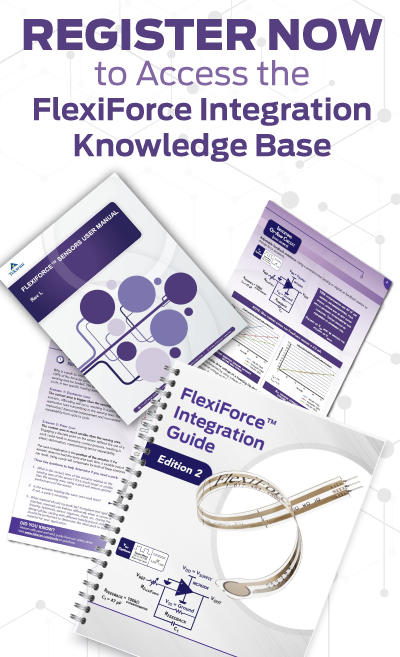TekTalk - Secrets to a Successful Sensor Integration - Question and Answer Podcast
Secrets to a Successful Sensor Integration
In this half-hour podcast, Tekscan's Ed Haidar answers several questions from design engineers considering FlexiForce sensors for their OEM project. Some of the questions included:
- Basic parameters to consider for characterizing force sensors
- Recommendations for interface materials to use with FlexiForce sensors
- Circuit recommendations for powering FlexiForce sensors
- Sensor force ranges, and how to utilize adjustable sensitivity capture higher force ranges with the FlexiForce sensor, and much more
Click the Video Player Below to Watch This Q&A Now!
Click to watch the full 6 Phases of Force Sensor Integration 30 minute webinar if you missed it.
Are you Working on a Your Next FlexiForce Sensor Integration Project?Register from the form below to access the FlexiForce Integration Knowledge Base, an entire library of useful FlexiForce sensor integration documents, articles, videos, and other critical content. |  |
Flexiforce Integration Q&ATranscript:
Q: Is there a specific sensor characterization checklist of the attributes you'd recommend engineers to follow before moving on to later stages of integration?
A: What I would recommend when beginning a sensor characterization would be, if you're using our sensor characterization kit you're going to find it comes with three different analog circuit modules. Each analog circuit module is a different analog circuit. One of them is a non-inverting op amp configuration. The other is an inverting op amp configuration and finally a voltage divider. What I would first recommend is taking your sensor and characterizing it using the automated loading profile for linearity, on the characterization fixture. It's a five-step linearity test it's fairly quick to run the profile and what you'll see is the voltage verse force curve for that sensor under the selected circuit.
Once you run the linearity profile for the three circuits that are included with the characterization kit, what you could do is compare the outputs and essentially determine the sensor response that works best for you given the considerations of your anticipated application. Now once you've gone ahead and got an idea which circuit is going to be best for you, the next step would be to run the other pre-programmed loading profiles which are his linearity, hysteresis, drift, and repeatability. What that will do is give you, as we said in the presentation, a performance baseline of the sensor relative to some of its key parameters in terms of those sensor properties. Then once you've gone ahead and characterized the chosen circuit with the different loading profiles, then I would recommend inserting the material interfaces that you're considering to be in contact with the sensor. What this will allow you to do is compare the sensor output just by itself and with the chosen loading interface materials. This will give you an idea what your loading interface materials will do to your sensor response and using the onboard adjustable reference voltage or swapping out the resistor and capacitor values, you can optimize the voltage and component values for the interface material that you're gonna go ahead and start proving the concept with and prototyping with. So that would be the checklist that I would recommend for sensor characterization.
Q: I'm considering a custom sensor for my device. Can you tell me about the sensor customization process?
The sensor customization process is pretty collaborative with Tekscan, on both our sales engineering side and our applications engineering side. Generally, the process will involve an engagement with our sales engineering team. What they'll do is they'll work with you to quantify the application to understand your needs of the sensor, the technology. And then they'll bring in an applications engineer, such as myself to work with you and understand the technical needs of the application.
Once we have an understanding of the technical needs of the application we can determine the type of pressure-sensitive ink that's ideal for the application, we can determine the type of substrate that's ideal for the application, depending on the temperature the force range of the application and in other application parameters. Once we’ve understood the technical needs of the application we can work with, or what we'll do is we'll take your desired sensor design itself in terms of geometry, shape, size, sensor termination, and we'll work with our mechanical design team to incorporate that into our manufacturing process. Then we'll collaborate back and forth with you on the given design that you're considering to ensure that it's optimal. Then there'll be a prototype phase for the custom sensor where you'll get some samples, you'll get some prototypes, you'll determine that, yes, these are optimal for the application or no, something needs to be tweaked. And then after that collaboration, we'd move on to a final production of the custom sensor.
So in terms of what we'll be looking at during the sensor customization, anything from the size of the sensor overall shape or geometry, the electrical termination, the force sensing range, the operating temperature these are all examples of elements of the sensor that can be customized to your specific application.
